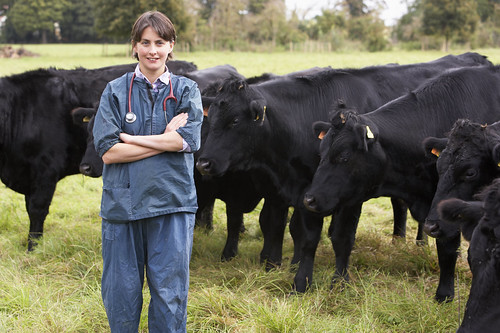
The Veterinary Medicine Loan Repayment Program helps vets repay qualified student loans for service as food animal veterinarians in selected areas of the country. (iStock image)
This post is part of the Science Tuesday feature series on the USDA blog. Check back each week as we showcase stories and news from USDA’s rich science and research portfolio.
A solid education is crucial to those seeking careers in animal science. However, many student loans can be burdensome. But a student loan payment the size of a mortgage couldn’t stop someone who has wanted to be a veterinarian since they learned to talk. Dr. Annie Bowes is one of those people.
After acquiring the knowledge to begin her dream career, Dr. Bowes was left with overwhelming debt. Luckily for this Idaho-based veterinarian, she wasn’t left alone to repay it. In 2011, she received assistance through the Veterinary Medicine Loan Repayment Program (VMLRP) a program funded by USDA’s National Institute of Food and Agriculture (NIFA).
Through VMLRP, NIFA may repay up to $25,000 each year of student loan debt to eligible veterinarians. In return, qualified veterinarians must agree to provide food animal medical care for three years in certain high-priority veterinary shortage situations. VMLRP has helped 245 veterinarians since the program’s inception in 2010.
“I am thankful for this assistance,” Bowes said. “It allowed me to establish myself in a rural area where it’s difficult to be successful. I am now able to treat animals at six to eight different farms per day and have more than 600 repeat clients.”
Veterinarians are critical to America’s food safety, food security, and to the health and well-being of both animals and humans. Studies indicate there are significant shortages of food animal veterinarians in certain areas of the country. A leading cause for the scarcity in this profession is the heavy price tag that four years of professional veterinary medical training carries, which leaves current graduates of veterinary colleges with an average debt of $162,000.
Bowes owns Aspen Veterinary Service, a mobile service treating large animals, as well as an Emergency Clinic with a staff of 15 and more than 10,000 repeat customers.
Dr. Tim VanDerPloeg is another veterinarian using USDA’s assistance to expand rural veterinary services. VanDerPloeg will open Veterinary Center of Somerset, in Kentucky, soon. Pulaski County, where the clinic will be located, is the third largest cattle county in the state of Kentucky. The clinic will have a 2,300-square-foot large animal facility in addition to the 3,400-square-foot small animal facility.
“Although recipients of the loan repayment assistance are only required to commit to three years of veterinary service in a designated shortage area, veterinarians like Bowes and VanDerPloeg suggest that the impacts from this funding and connections to their service areas go well beyond three years,” said Gary Sherman, VMLRP national program leader with NIFA.
Through federal funding and leadership for research, education, and extension programs, NIFA focuses on investing in science and solving critical issues impacting people’s daily lives and the nation’s future. For more information, visit www.nifa.usda.gov.
Tags: AMS, APHIS, ARRA, ARS, California, Conservation, drought, Energy, Farm Bill, Farmers, FAS, FNS, Food and Nutrition, Food Farm and Jobs Bill, Food Safety, Forestry, FS, FSA, FSIS, HealthierNextGen, Kathleen Merrigan, KYF2, Let's Move, NASS, National School Lunch Program, NIFA, NRCS, Nutrition, People's Garden, President Obama, Producers, Ranchers, RD, Rural America, Rural Development, Science, Science Tuesday, Secretary's Column, SNAP, South Dakota, Texas, Tom Vilsack, Trade, Tribal, USDA,
No comments:
Post a Comment